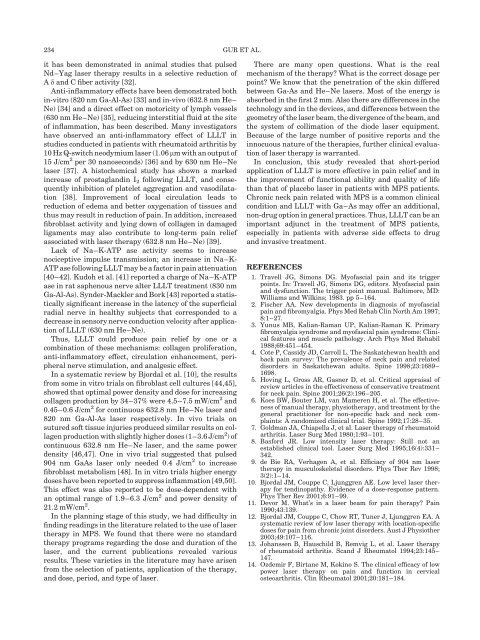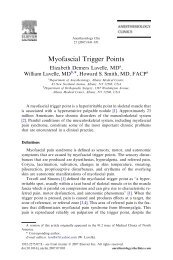Efficacy of 904 nm gallium arsenide low level laser therapy in the ...
Efficacy of 904 nm gallium arsenide low level laser therapy in the ...
Efficacy of 904 nm gallium arsenide low level laser therapy in the ...
You also want an ePaper? Increase the reach of your titles
YUMPU automatically turns print PDFs into web optimized ePapers that Google loves.
234 GUR ET AL.<br />
it has been demonstrated <strong>in</strong> animal studies that pulsed<br />
Nd–Yag <strong>laser</strong> <strong><strong>the</strong>rapy</strong> results <strong>in</strong> a selective reduction <strong>of</strong><br />
A d and C fiber activity [32].<br />
Anti-<strong>in</strong>flammatory effects have been demonstrated both<br />
<strong>in</strong>-vitro (820 <strong>nm</strong> Ga-Al-As) [33] and <strong>in</strong>-vivo (632.8 <strong>nm</strong> He–<br />
Ne) [34] and a direct effect on motoricity <strong>of</strong> lymph vessels<br />
(630 <strong>nm</strong> He–Ne) [35], reduc<strong>in</strong>g <strong>in</strong>terstitial fluid at <strong>the</strong> site<br />
<strong>of</strong> <strong>in</strong>flammation, has been described. Many <strong>in</strong>vestigators<br />
have observed an anti-<strong>in</strong>flammatory effect <strong>of</strong> LLLT <strong>in</strong><br />
studies conducted <strong>in</strong> patients with rheumatoid arthritis by<br />
10 Hz Q-switch neodymium <strong>laser</strong> (1.06 mm with an output <strong>of</strong><br />
15 J/cm 2 per 30 nanoseconds) [36] and by 630 <strong>nm</strong> He–Ne<br />
<strong>laser</strong> [37]. A histochemical study has shown a marked<br />
<strong>in</strong>crease <strong>of</strong> prostagland<strong>in</strong> I2 fol<strong>low</strong><strong>in</strong>g LLLT, and consequently<br />
<strong>in</strong>hibition <strong>of</strong> platelet aggregation and vasodilatation<br />
[38]. Improvement <strong>of</strong> local circulation leads to<br />
reduction <strong>of</strong> edema and better oxygenation <strong>of</strong> tissues and<br />
thus may result <strong>in</strong> reduction <strong>of</strong> pa<strong>in</strong>. In addition, <strong>in</strong>creased<br />
fibroblast activity and ly<strong>in</strong>g down <strong>of</strong> collagen <strong>in</strong> damaged<br />
ligaments may also contribute to long-term pa<strong>in</strong> relief<br />
associated with <strong>laser</strong> <strong><strong>the</strong>rapy</strong> (632.8 <strong>nm</strong> He–Ne) [39].<br />
Lack <strong>of</strong> Na–K-ATP ase activity seems to <strong>in</strong>crease<br />
nociceptive impulse transmission; an <strong>in</strong>crease <strong>in</strong> Na–K-<br />
ATP ase fol<strong>low</strong><strong>in</strong>g LLLT may be a factor <strong>in</strong> pa<strong>in</strong> attenuation<br />
[40–42]. Kudoh et al. [41] reported a charge <strong>of</strong> Na–K-ATP<br />
ase <strong>in</strong> rat saphenous nerve alter LLLT treatment (830 <strong>nm</strong><br />
Ga-Al-As). Synder-Mackler and Bork [43] reported a statistically<br />
significant <strong>in</strong>crease <strong>in</strong> <strong>the</strong> latency <strong>of</strong> <strong>the</strong> superficial<br />
radial nerve <strong>in</strong> healthy subjects that corresponded to a<br />
decrease <strong>in</strong> sensory nerve conduction velocity after application<br />
<strong>of</strong> LLLT (630 <strong>nm</strong> He–Ne).<br />
Thus, LLLT could produce pa<strong>in</strong> relief by one or a<br />
comb<strong>in</strong>ation <strong>of</strong> <strong>the</strong>se mechanisms: collagen proliferation,<br />
anti-<strong>in</strong>flammatory effect, circulation enhancement, peripheral<br />
nerve stimulation, and analgesic effect.<br />
In a systematic review by Bjordal et al. [10], <strong>the</strong> results<br />
from some <strong>in</strong> vitro trials on fibroblast cell cultures [44,45],<br />
showed that optimal power density and dose for <strong>in</strong>creas<strong>in</strong>g<br />
collagen production by 34–37% were 4.5–7.5 mW/cm 2 and<br />
0.45–0.6 J/cm 2 for cont<strong>in</strong>uous 632.8 <strong>nm</strong> He–Ne <strong>laser</strong> and<br />
820 <strong>nm</strong> Ga-Al-As <strong>laser</strong> respectively. In vivo trials on<br />
sutured s<strong>of</strong>t tissue <strong>in</strong>juries produced similar results on collagen<br />
production with slightly higher doses (1–3.6 J/cm 2 )<strong>of</strong><br />
cont<strong>in</strong>uous 632.8 <strong>nm</strong> He–Ne <strong>laser</strong>, and <strong>the</strong> same power<br />
density [46,47]. One <strong>in</strong> vivo trial suggested that pulsed<br />
<strong>904</strong> <strong>nm</strong> GaAs <strong>laser</strong> only needed 0.4 J/cm 2 to <strong>in</strong>crease<br />
fibroblast metabolism [48]. In <strong>in</strong> vitro trials higher energy<br />
doses have been reported to suppress <strong>in</strong>flammation [49,50].<br />
This effect was also reported to be dose-dependent with<br />
an optimal range <strong>of</strong> 1.9–6.3 J/cm 2 and power density <strong>of</strong><br />
21.2 mW/cm 2 .<br />
In <strong>the</strong> plann<strong>in</strong>g stage <strong>of</strong> this study, we had difficulty <strong>in</strong><br />
f<strong>in</strong>d<strong>in</strong>g read<strong>in</strong>gs <strong>in</strong> <strong>the</strong> literature related to <strong>the</strong> use <strong>of</strong> <strong>laser</strong><br />
<strong><strong>the</strong>rapy</strong> <strong>in</strong> MPS. We found that <strong>the</strong>re were no standard<br />
<strong><strong>the</strong>rapy</strong> programs regard<strong>in</strong>g <strong>the</strong> dose and duration <strong>of</strong> <strong>the</strong><br />
<strong>laser</strong>, and <strong>the</strong> current publications revealed various<br />
results. These varieties <strong>in</strong> <strong>the</strong> literature may have arisen<br />
from <strong>the</strong> selection <strong>of</strong> patients, application <strong>of</strong> <strong>the</strong> <strong><strong>the</strong>rapy</strong>,<br />
and dose, period, and type <strong>of</strong> <strong>laser</strong>.<br />
There are many open questions. What is <strong>the</strong> real<br />
mechanism <strong>of</strong> <strong>the</strong> <strong><strong>the</strong>rapy</strong>? What is <strong>the</strong> correct dosage per<br />
po<strong>in</strong>t? We know that <strong>the</strong> penetration <strong>of</strong> <strong>the</strong> sk<strong>in</strong> differed<br />
between Ga-As and He–Ne <strong>laser</strong>s. Most <strong>of</strong> <strong>the</strong> energy is<br />
absorbed <strong>in</strong> <strong>the</strong> first 2 mm. Also <strong>the</strong>re are differences <strong>in</strong> <strong>the</strong><br />
technology and <strong>in</strong> <strong>the</strong> devices, and differences between <strong>the</strong><br />
geometry <strong>of</strong> <strong>the</strong> <strong>laser</strong> beam, <strong>the</strong> divergence <strong>of</strong> <strong>the</strong> beam, and<br />
<strong>the</strong> system <strong>of</strong> collimation <strong>of</strong> <strong>the</strong> diode <strong>laser</strong> equipment.<br />
Because <strong>of</strong> <strong>the</strong> large number <strong>of</strong> positive reports and <strong>the</strong><br />
<strong>in</strong>nocuous nature <strong>of</strong> <strong>the</strong> <strong>the</strong>rapies, fur<strong>the</strong>r cl<strong>in</strong>ical evaluation<br />
<strong>of</strong> <strong>laser</strong> <strong><strong>the</strong>rapy</strong> is warranted.<br />
In conclusion, this study revealed that short-period<br />
application <strong>of</strong> LLLT is more effective <strong>in</strong> pa<strong>in</strong> relief and <strong>in</strong><br />
<strong>the</strong> improvement <strong>of</strong> functional ability and quality <strong>of</strong> life<br />
than that <strong>of</strong> placebo <strong>laser</strong> <strong>in</strong> patients with MPS patients.<br />
Chronic neck pa<strong>in</strong> related with MPS is a common cl<strong>in</strong>ical<br />
condition and LLLT with Ga–As may <strong>of</strong>fer an additional,<br />
non-drug option <strong>in</strong> general practices. Thus, LLLT can be an<br />
important adjunct <strong>in</strong> <strong>the</strong> treatment <strong>of</strong> MPS patients,<br />
especially <strong>in</strong> patients with adverse side effects to drug<br />
and <strong>in</strong>vasive treatment.<br />
REFERENCES<br />
1. Travell JG, Simons DG. My<strong>of</strong>ascial pa<strong>in</strong> and its trigger<br />
po<strong>in</strong>ts. In: Travell JG, Simons DG, editors. My<strong>of</strong>ascial pa<strong>in</strong><br />
and dysfunction. The trigger po<strong>in</strong>t manual. Baltimore, MD:<br />
Williams and Wilk<strong>in</strong>s; 1983. pp 5–164.<br />
2. Fischer AA. New developments <strong>in</strong> diagnosis <strong>of</strong> my<strong>of</strong>ascial<br />
pa<strong>in</strong> and fibromyalgia. Phys Med Rehab Cl<strong>in</strong> North Am 1997;<br />
8:1–27.<br />
3. Yunus MB, Kalian-Raman UP, Kalian-Raman K. Primary<br />
fibromyalgia syndrome and my<strong>of</strong>ascial pa<strong>in</strong> syndrome: Cl<strong>in</strong>ical<br />
features and muscle pathology. Arch Phys Med Rehabil<br />
1988;69:451–454.<br />
4. Cote P, Cassidy JD, Carroll L. The Saskatchewan health and<br />
back pa<strong>in</strong> survey: The prevalence <strong>of</strong> neck pa<strong>in</strong> and related<br />
disorders <strong>in</strong> Saskatchewan adults. Sp<strong>in</strong>e 1998;23:1689–<br />
1698.<br />
5. Hov<strong>in</strong>g L, Gross AR, Gasner D, et al. Critical appraisal <strong>of</strong><br />
review articles <strong>in</strong> <strong>the</strong> effectiveness <strong>of</strong> conservative treatment<br />
for neck pa<strong>in</strong>. Sp<strong>in</strong>e 2001;26(2):196–205.<br />
6. Koes BW, Bouter LM, van Mameren H, et al. The effectiveness<br />
<strong>of</strong> manual <strong><strong>the</strong>rapy</strong>, physio<strong><strong>the</strong>rapy</strong>, and treatment by <strong>the</strong><br />
general practitioner for non-specific back and neck compla<strong>in</strong>ts:<br />
A randomized cl<strong>in</strong>ical trial. Sp<strong>in</strong>e 1992;17:28–35.<br />
7. Goldman JA, Chiapella J, et al. Laser <strong><strong>the</strong>rapy</strong> <strong>of</strong> rheumatoid<br />
arthritis. Laser Surg Med 1980;1:93–101.<br />
8. Basford JR. Low <strong>in</strong>tensity <strong>laser</strong> <strong><strong>the</strong>rapy</strong>: Still not an<br />
established cl<strong>in</strong>ical tool. Laser Surg Med 1995;16(4):331–<br />
342.<br />
9. de Bie RA, Verhagen A, et al. Efficiacy <strong>of</strong> <strong>904</strong> <strong>nm</strong> <strong>laser</strong><br />
<strong><strong>the</strong>rapy</strong> <strong>in</strong> musculoskeletal disorders. Phys Ther Rev 1998;<br />
3(2):1–14.<br />
10. Bjordal JM, Couppe C, Ljunggren AE. Low <strong>level</strong> <strong>laser</strong> <strong><strong>the</strong>rapy</strong><br />
for tend<strong>in</strong>opathy. Evidence <strong>of</strong> a dose-response pattern.<br />
Phys Ther Rev 2001;6:91–99.<br />
11. Devor M. What’s <strong>in</strong> a <strong>laser</strong> beam for pa<strong>in</strong> <strong><strong>the</strong>rapy</strong>? Pa<strong>in</strong><br />
1990;43:139.<br />
12. Bjordal JM, Couppe C, Chow RT, Tuner J, Ljunggren EA. A<br />
systematic review <strong>of</strong> <strong>low</strong> <strong>laser</strong> <strong><strong>the</strong>rapy</strong> with location-specific<br />
doses for pa<strong>in</strong> from chronic jo<strong>in</strong>t disorders. Aust J Physio<strong>the</strong>r<br />
2003;49:107–116.<br />
13. Johanssen B, Hauschild B, Remvig L, et al. Laser <strong><strong>the</strong>rapy</strong><br />
<strong>of</strong> rheumatoid arthritis. Scand J Rheumatol 1994;23:145–<br />
147.<br />
14. Ozdemir F, Birtane M, Kok<strong>in</strong>o S. The cl<strong>in</strong>ical efficacy <strong>of</strong> <strong>low</strong><br />
power <strong>laser</strong> <strong><strong>the</strong>rapy</strong> on pa<strong>in</strong> and function <strong>in</strong> cervical<br />
osteoarthritis. Cl<strong>in</strong> Rheumatol 2001;20:181–184.




